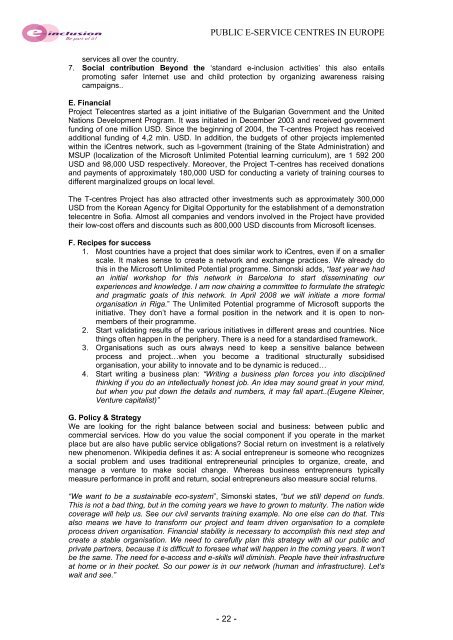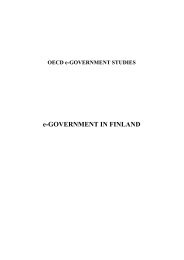Comparative Study of Public e-Service Centres in - ePractice.eu
Comparative Study of Public e-Service Centres in - ePractice.eu
Comparative Study of Public e-Service Centres in - ePractice.eu
You also want an ePaper? Increase the reach of your titles
YUMPU automatically turns print PDFs into web optimized ePapers that Google loves.
PUBLIC E-SERVICE CENTRES IN EUROPE<br />
services all over the country.<br />
7. Social contribution Beyond the ‘standard e-<strong>in</strong>clusion activities’ this also entails<br />
promot<strong>in</strong>g safer Internet use and child protection by organiz<strong>in</strong>g awareness rais<strong>in</strong>g<br />
campaigns..<br />
E. F<strong>in</strong>ancial<br />
Project Telecentres started as a jo<strong>in</strong>t <strong>in</strong>itiative <strong>of</strong> the Bulgarian Government and the United<br />
Nations Development Program. It was <strong>in</strong>itiated <strong>in</strong> December 2003 and received government<br />
fund<strong>in</strong>g <strong>of</strong> one million USD. S<strong>in</strong>ce the beg<strong>in</strong>n<strong>in</strong>g <strong>of</strong> 2004, the T-centres Project has received<br />
additional fund<strong>in</strong>g <strong>of</strong> 4,2 mln. USD. In addition, the budgets <strong>of</strong> other projects implemented<br />
with<strong>in</strong> the i<strong>Centres</strong> network, such as I-government (tra<strong>in</strong><strong>in</strong>g <strong>of</strong> the State Adm<strong>in</strong>istration) and<br />
MSUP (localization <strong>of</strong> the Micros<strong>of</strong>t Unlimited Potential learn<strong>in</strong>g curriculum), are 1 592 200<br />
USD and 98,000 USD respectively. Moreover, the Project T-centres has received donations<br />
and payments <strong>of</strong> approximately 180,000 USD for conduct<strong>in</strong>g a variety <strong>of</strong> tra<strong>in</strong><strong>in</strong>g courses to<br />
different marg<strong>in</strong>alized groups on local level.<br />
The T-centres Project has also attracted other <strong>in</strong>vestments such as approximately 300,000<br />
USD from the Korean Agency for Digital Opportunity for the establishment <strong>of</strong> a demonstration<br />
telecentre <strong>in</strong> S<strong>of</strong>ia. Almost all companies and vendors <strong>in</strong>volved <strong>in</strong> the Project have provided<br />
their low-cost <strong>of</strong>fers and discounts such as 800,000 USD discounts from Micros<strong>of</strong>t licenses.<br />
F. Recipes for success<br />
1. Most countries have a project that does similar work to i<strong>Centres</strong>, even if on a smaller<br />
scale. It makes sense to create a network and exchange practices. We already do<br />
this <strong>in</strong> the Micros<strong>of</strong>t Unlimited Potential programme. Simonski adds, “last year we had<br />
an <strong>in</strong>itial workshop for this network <strong>in</strong> Barcelona to start dissem<strong>in</strong>at<strong>in</strong>g our<br />
experiences and knowledge. I am now chair<strong>in</strong>g a committee to formulate the strategic<br />
and pragmatic goals <strong>of</strong> this network. In April 2008 we will <strong>in</strong>itiate a more formal<br />
organisation <strong>in</strong> Riga.” The Unlimited Potential programme <strong>of</strong> Micros<strong>of</strong>t supports the<br />
<strong>in</strong>itiative. They don’t have a formal position <strong>in</strong> the network and it is open to nonmembers<br />
<strong>of</strong> their programme.<br />
2. Start validat<strong>in</strong>g results <strong>of</strong> the various <strong>in</strong>itiatives <strong>in</strong> different areas and countries. Nice<br />
th<strong>in</strong>gs <strong>of</strong>ten happen <strong>in</strong> the periphery. There is a need for a standardised framework.<br />
3. Organisations such as ours always need to keep a sensitive balance between<br />
process and project…when you become a traditional structurally subsidised<br />
organisation, your ability to <strong>in</strong>novate and to be dynamic is reduced…<br />
4. Start writ<strong>in</strong>g a bus<strong>in</strong>ess plan: “Writ<strong>in</strong>g a bus<strong>in</strong>ess plan forces you <strong>in</strong>to discipl<strong>in</strong>ed<br />
th<strong>in</strong>k<strong>in</strong>g if you do an <strong>in</strong>tellectually honest job. An idea may sound great <strong>in</strong> your m<strong>in</strong>d,<br />
but when you put down the details and numbers, it may fall apart..(Eugene Kle<strong>in</strong>er,<br />
Venture capitalist)”<br />
G. Policy & Strategy<br />
We are look<strong>in</strong>g for the right balance between social and bus<strong>in</strong>ess: between public and<br />
commercial services. How do you value the social component if you operate <strong>in</strong> the market<br />
place but are also have public service obligations? Social return on <strong>in</strong>vestment is a relatively<br />
new phenomenon. Wikipedia def<strong>in</strong>es it as: A social entrepren<strong>eu</strong>r is someone who recognizes<br />
a social problem and uses traditional entrepren<strong>eu</strong>rial pr<strong>in</strong>ciples to organize, create, and<br />
manage a venture to make social change. Whereas bus<strong>in</strong>ess entrepren<strong>eu</strong>rs typically<br />
measure performance <strong>in</strong> pr<strong>of</strong>it and return, social entrepren<strong>eu</strong>rs also measure social returns.<br />
“We want to be a susta<strong>in</strong>able eco-system”, Simonski states, “but we still depend on funds.<br />
This is not a bad th<strong>in</strong>g, but <strong>in</strong> the com<strong>in</strong>g years we have to grown to maturity. The nation wide<br />
coverage will help us. See our civil servants tra<strong>in</strong><strong>in</strong>g example. No one else can do that. This<br />
also means we have to transform our project and team driven organisation to a complete<br />
process driven organisation. F<strong>in</strong>ancial stability is necessary to accomplish this next step and<br />
create a stable organisation. We need to carefully plan this strategy with all our public and<br />
private partners, because it is difficult to foresee what will happen <strong>in</strong> the com<strong>in</strong>g years. It won’t<br />
be the same. The need for e-access and e-skills will dim<strong>in</strong>ish. People have their <strong>in</strong>frastructure<br />
at home or <strong>in</strong> their pocket. So our power is <strong>in</strong> our network (human and <strong>in</strong>frastructure). Let's<br />
wait and see.”<br />
- 22 -
















